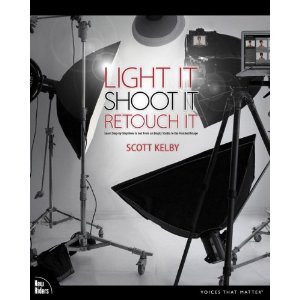The two newest books to my photography library have been two highly anticipated lighting books; Kevin Kubota’s Lighting Notebook, and Scott Kelby’s Light It Shoot It Retouch It. About a month ago I reviewed Kevin’s book and you guys seemed to respond to that positively. You can find that review here. I’ve finally gotten around to putting my thoughts on Scott’s book down in writing. If you don’t know who Scott Kelby is, you should look him up right now. His current accolades include president of the National Association of Photoshop Professionals, editor-in-chief of Photoshop User magazine, and founder of KelbyTraining.com. He is a true professional photographer and he’s willing to share all of his knowledge with everyone. He has been a major influence on me during my photographic career. His newest book, Light It Shoot It Retouch It, is the latest in a line of books he’s authored.
If you read my review of Lighting Notebook by Kevin Kubota, you’ll remember how I said about 1/4th of that book is about general equipment information and how to get started with shooting artificially lit images. The other 3/4th of the book is image breakdowns in detail from equipment used, lighting placement and settings. That is where the information in that book ends, but not in Scott Kelby’s book.
Let me explain a little further. We all know that pressing the shutter is not the final step in creating great images. There’s the all important step of post-processing to finalize the image. Scott’s book is very similar to Kevin’s however it takes that extra step into the post-processing realm.
Scott will talk you in detail through 12 completely different shoots. Each one consists of general setup description, equipment used, power settings on each light, and camera settings. He’ll then present you with many different shots of the setup from all angles so you can visually see how the shot was lit. And then comes the fun part; step-by-step instructions on what to do in Photoshop to achieve the final image. The sample images are even downloadable so you can follow along and perform the edits in your own home.
Even though Kevin’s book shows you a whopping 101 scenarios, I feel Scott’s book is slightly better as it goes through the entire process all the way through editing to get the final image. The editing sections are broken down in simple steps with a picture and a down-to-earth explanation of what to do in that step.
While Light It Shoot It Retouch It does have an intro section with some information about gear and what was used to create the images in the book, it’s nothing like that of Lighting Notebook’s. As these books are marketed towards people who are newer to lighting (even though a seasoned vet can get some great info out of them), I feel this is where Scott’s book misses out a bit.
In the end, this is a great book for learning studio lighting. You can get through it pretty quickly as there are a ton of images which is a good thing for a book like this. I would definitely recommend to go through the sample images on your computer as you read since it’s much more difficult to retain retouching info if you aren’t actually making the edits yourself.
I know I talked about Kevin’s book a lot in this review of Scott’s, but I almost think of them as one book. Let me explain why I say that. Kevin Kubotas Lighting Notebook starts from the very beginning, with tons of getting started from scratch info. Then it goes into lighting scenarios with general info. This is where Scott’s Light It Shoot It Retouch It
picks up. You get more lighting scenarios but with a vast amount more explanation for each and then moves into the computer to edit and finalize the images. An all-inclusive light learning path across two fantastic books.
Please Support The Phoblographer
We love to bring you guys the latest and greatest news and gear related stuff. However, we can’t keep doing that unless we have your continued support. If you would like to purchase any of the items mentioned, please do so by clicking our links first and then purchasing the items as we then get a small portion of the sale to help run the website.


